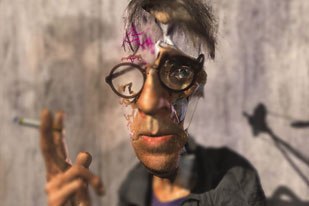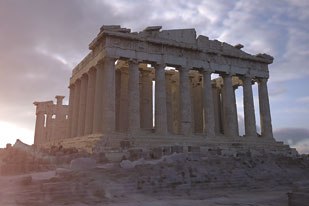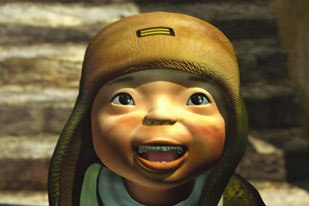The Career Coach takes on a common obstacle in any career -- shyness.

The interaction of CG and live action was one of the topics that summer blockbusters such as Spider-Man 2 brought up at this year's SIGGRAPH. & © 2004 Marvel Characters Inc. © 2004 Sony Pictures Digital. All rights rese
The SIGGRAPH 2004 Computer Animation Festival presents the best work from the recent past. SIGGRAPH's Emerging Technologies exhibition shows the shape of things to come. For visual effects practioners, the festival offers exemplary artistic and technical breakthroughs, while the exhibition offers a few technologies that that might play a role in the future creation or experience of visual effects.
The Festival
Ask any attendee, "What's the coolest thing about being at SIGGRAPH?" Chances are the Computer Animation Festival, consisting of the Electronic Theater and the Animation Theater, ranks right up there with free penlights and open bars. Of course, you see much of the work in the festival on the screens downstairs in the Exhibition Hall adding luster to products used in the creation of the work. But it's only in the cool dark rooms of the Electronic and Animation Theaters where you really get a chance to rest your legs and take a break from the sensory onslaught that is SIGGRAPH to see what some of your fellow seekers have been up to over the past year or so.
For SIGGRAPH 2004, the festival jury accepted 83 works out of a record 643 submissions from around the globe. Nearly a third of the submissions were from students, nearly half were from outside the United States.
The shorts presented run the gamut from excerpts of major visual effects sequences from feature films to 2D and 3D animated shorts, television commercials and medical visualizations. Some shorts were vehicles for new production techniques, others served as resumes and calling cards for companies and computer graphics students. In this writer's view, if you are part of the industry you need to see the festival if only to energize yourself by watching the accomplishments of others in your field.
Now Featuring
This has been an evolutionary year for visual effects in feature films and, as expected, the festival contained several selections from effects-driven blockbusters. With these projects, the industry has achieved new benchmarks in fluid dynamics (The Day After Tomorrow), crowd simulations (The Lord of the Ring: Return of the King), melding CG characters with live-action characters (Spider-Man 2), increasingly detailed skin, hair and cloth (Matrix Revolutions, Shrek 2) and all of the above.
The technical advances of these major studio efforts have been covered extensively in VFXWorld and elsewhere, so let's take a walk through this year's lesser-known offerings to see what lies beyond the blockbuster.
Losing It
If you see nothing else from this year's festival, you must see Ryan, directed by Chris Landreth and produced by National Film Board of Canada. Winning the SIGGRAPH 2004 Jury Award and honors at many other festivals, Ryan is a 3D hand-animated symphony of creativity and color. Based on the short, brilliant career of animation pioneer Ryan Larkin, Ryan asks fundamental questions about art and artists in the modern world. Ryan stuns us with a visceral graphic style creator Landreth calls "psychological realism." Characters take on the appearance of fleeting thoughts or familiar nightmares. Even the minor players in the story seem to have curious histories on par with those of Larkin.

Ryan is the talk of the festival circuit and SIGGRAPH attendees had the chance to catch the craze. © Copper Heart Ent. and the National Film Board of Canada.
Landreth used a variety of digital and pre-digital techniques to create his characters and environment. He brings to the screen mastery of 2D and 3D techniques and combines them with artistic inspirations from the Old Masters from Dali to Zippy the Clown. Unlike many of its counterparts, Ryan stands up to repeated viewing. It should inspire anyone trying to imbue characters with authentic emotions or creating environments that add to the depth of characters.
Depth/Perception
One of the more enchanting offerings was Mamoru Oshii's Ghost in the Shell 2: Innocence. An excerpt from a manga-inspired limited release animated feature film, this Festival selection presents dreamlike retro-futuristic urban canyons as a backdrop for a strange parade. Ghost in the Shell 2: Innocence reminds us that 2D animation will continue to have a role in epic visual storytelling despite the current rage in the marketplace for 3D animation. This selection also underlines the ongoing influence of Asian art and storytelling on world culture.
Changing Your Viewpoint
Massive Arabesque by Larry Zitnick of Microsoft Research demonstrates a technology called "video view interpolation," which allows a user to change the viewpoint of a live-action video while watching it. The work features a group of real-life virtuoso break dancers doing a dance-off in a nondescript stairwell. Don't let the grainy video throw you. This scene was captured simultaneously by eight cameras and then re-edited with "virtual" scenes interpolated from the original video sources. What this means is that someday, if you don't like the live-action footage you just shot, you just might be able to interpolate brand-new footage without reshooting.

Dr. Paul Debevec exquisitely recreates ancient Greece in his newest film, The Parthenon. © 2004 University of Southern California.
The Greek Way
Paul Debevec's The Parthenon (USC Institute for Creative Technologies) demonstrates advanced techniques for archiving cultural artifacts or creating virtual locations. Using the latest laser-scanning and photogrammetry techniques and Monte Carlo global illumination rendering, Parthenon brings together the Acropolis temple complex as it once was, before invasion and adventurers scattered these treasures around the globe.
As with his previous groundbreaking work in high dynamic range imaging, Debevec shows us how we can recreate physical locations in incredible detail from tools borrowed from science and defense. The Parthenon is art about art: a document celebrating outstanding efforts of the human intellect past and present.
Debevec's and ICT's work allows storytellers increasing flexibility to accurately recreate worlds that will never again exist in complete physical form. Such efforts underline the valuable work from artists and engineers who toil outside of the breathlessly over-hyped entertainment industry.

Sejong Park's Birthday Boy is gaining accolades as well as awards everywhere on screens. © Australian Film Television and Radio School.
Beginner's Mind
Of special note this year are two student-animated CG shorts. The first, Birthday Boy, by Sejong Park of the Australian Film Television and Radio School won the Festival's coveted "Best Animated Short." Park tells the story of a child during the Korean War who finds happiness in even the most tragic circumstances. One becomes so involved in the life of the main character that one believes this might very well have happen to the children of war.
Finally, Annie & Boo, by Johannes Welland and produced by Filmakademie Baden-Wurttemberg in Ludwigsburg, Germany, shows how two very different characters the feisty human Annie and the klutzy embodiment of coincidence Boo find common ground. Welland and his team create effective physical and emotional choreography between an imaginative girl and a character of legendary proportions.
These and other student works in the festival show that storytelling and technical ability continue to thrive outside of the Hollywood behemoth.
Technologies Emerging
If the Computer Animation Festival shows us the results of the tools and thinking of today, then SIGGRAPH's Emerging Technologies exhibition gives us glimpses of the tools we may use as both content creators and audiences in the future.
The SIGGRAPH 2004 Emerging Technologies exhibition included 30 installations from around the world, selected by a jury of industry experts from 114 submissions. According to Heather Eliot-Famularo, SIGGRAPH 2003 chair of Emerging Technologies: "In our daily routine we are surrounded by technology that enhances our life in many ways, both physically and psychologically. The exhibition showcases both scientific advances and fine art, with a major emphasis this year in display technology. Attendees experience virtual and augmented reality, imaging and video technology, interactive displays, robotics, mobile communication, realtime graphics, sensors, haptics, wearables and interactive fine art installations that may enhance our lives in the near and distant future." This is a longer way of saying what the exhibition is all about: "cool stuff you can interact with."

Penn State's Rebecca Strzelec's Written Brooch shows the advancing uses of CG in both art and elsewhere. © Rebecca Strzelec.
At SIGGRAPH's Emerging Technologies exhibition you meet the people doing research that might one day wind up in the tools you use to conceive, create and present your work. Reading a white paper is no substitute for talking directly to exhibitors and feeling their infectious enthusiasm for their work. The exhibition explores technical issues and methods that could span many articles. However, we will narrow our focus to a few installations whose underlying modes and methods may play significant future roles in the art and practice of visual effects.
Say Hello to SANDDE
One of the more intriguing installations in the ET pavilion was the 3D film June by Munro Ferguson and others (National Film Board of Canada). What was important about it went beyond the work itself (although the film was a highly engaging trip through trippy hand drawn objects in 3D space) and the technology used to display it (digital projectors and lightweight stereoscopic glasses). What was important was the technology used to create the film's images.
According to SIGGRAPH, SANDDE (Stereoscopic Animation Drawing Device) is a combination of specialized software and hardware for creating hand-drawn animation in 3D space and was developed for IMAX Corp. Unlike other forms of computer-generated stereographic imagery, SANDDE uses lines that are drawn by hand, literally in space, rather than mathematically generated 3D models, which lack the spontaneity and expressiveness of drawings made by hand.
This installation shows that drawing is not just a 2D affair. June depicts the very beginning of real-time design of this kind. Even the most powerful floating point GPU with realtime pixel-level shading requires an interface of keyboard, mouse and/or stylus and board. One cannot help thinking that these current tools limit the creative reach of many artists. The mind reels with possibilities for rapidly designing visual effects in 3D space using natural human movements of sketching rather than an arcane series of keyboard and mouse commands. Combine this with some of the other collaborative creative technologies demonstrated at the exhibition and it's not too hard to imagine breaking away from the tyranny of the computer generated vector or bitmap while still working in three dimensions.
Tweaking the Palettes of Life
Other exhibition offerings have potentially huge impacts on both the authoring and display of visual effects imagery. One offering, Irodori, uses custom software and hardware to expands the RGB color space to a color space closer to natural human vision. The expansion of palettes will allow greater freedom for visual effects artists to create new combinations of colors to literally "set the tone" of their work.
$90,000 for a Monitor?
And just in case you were wondering how to display these expanded palettes on workstations, display makers are developing novel workarounds to current technical limitations of color reproduction. Case in point is Sunnybrook Technologies' prototype HDR monitor, which offers "300 times higher contrast, 10-30 times higher brightness, 10-30 times lower `darkness,' and 38% better coverage of the NTSC color gamut due to the use of RGB LED." All I can say is that it looked clearer than any monitor I have seen, creating the unnerving sensation that you are somehow seeing beyond a the display screen. Increasingly detailed displays (both monitors and projections) will keep content creators scrambling to create more detailed characters, environments and events. And the price will be coming down we can only hope.

Will Sunnybrook Technologies' prototype HDR monitor be worth its price tag?
May the Force Feedback Be With You
Force feedback, an implementation of "haptics" (meaning "of or relating to the sense of touch: tactile") provides both artist and audience the ability to generate and experience changes in tactile sensations. Several ET installations address how to simulate these sensations including a floor that allows you to walk (as opposed to merely floating) in a virtual world by tracking your body position and direction (CirculaFloor), a harness that provides the sensation of swimming (Swimming Across the Pacific) and a rig that gently strokes your body as it creates a 3D map of it (Tickle Salon). Most importantly for visual effects people, force feedback input devices will likely become more and more prevalent method for interacting with data first on the authoring side, then on the audience side.
Interpolate or Die
Liflet from University of Tokyo is a live demonstration of image interpolation technology echoing that used in the Computer Animation Festival's Massive Arabesque discussed earlier. Liflet uses specialized lenses, hardware and software to created interpolated views from fixed cameras in real time. This and similar technologies will allow visual effects creators to use interpolated viewpoints to expand their creative reach.
Wrapping It Up
Of course, it's unlikely we will see many of these emerging technologies in anything like their exhibited form in the near future. Most likely, these tools will be buried in an aggregate of other technologies within toolsets. Other technical advances, for example, in nanoscale materials, quantum computing, the manipulation of light and energy will be crucial in bringing the ideas presented in the exhibition within reach of the rest of us.

Liflet uses specialized lenses, hardware and software to created interpolated views from fixed cameras in realtime. © The University of Tokyo.
Equally as important, these new methods and understandings may give rise to forms of organization more in tune with the creative process than the hierarchical, top-down modes currently in wide practice. Perhaps a small visual effects organization will use such technologies to conceive, design and generate images of greater value to audiences than organizations employing the one-person one-workstation model. Maybe we will see early version of this work in an upcoming Computer Animation Festival.
Maybe great audience experiences in the future will come not from a collection of individuals working on parts of a whole but from many people collaborating all-at-once to create and refine objects, characters and environments without regard to team members' physical location, language or culture.
Some day, using the tools first glimpsed at in the Emerging Technologies and later implemented in the Computer Animation Festival will enable creators to move into more the mysterious creative regions than ever before.
Visual effects producer Rick Baumgartner was recently nominated for a 2003 Primetime Emmy Award for his work on Buffy the Vampire Slayer. He is working on the NBC show Las Vegas at Stargate Digital. He can be reached via his Website: www.vfxproducer.com.







